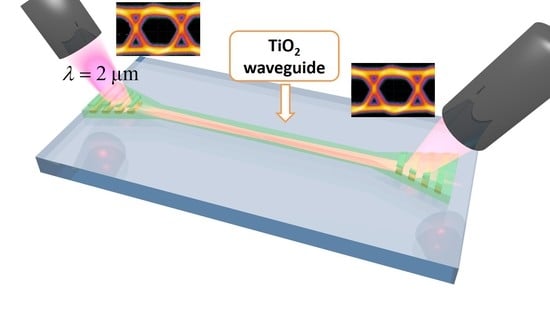Demonstration of High-Speed Optical Transmission at 2 µm in Titanium Dioxide Waveguides
Abstract
:1. Introduction
2. Design and Fabrication of the Photonic Structure
2.1. Design and Fabrication of the Photonic Structure
2.2. Modal Analysis
2.3. Fabrication
2.4. Test of the Device
3. Validation of the Transmission of a 10 Gbit/s Signal
4. Conclusions
Acknowledgments
Author Contributions
Conflicts of Interest
References
- Richardson, D.J. Filling the light pipe. Science 2010, 330, 327–328. [Google Scholar] [CrossRef] [PubMed]
- Ellis, A.D.; Suibhne, N.M.; Saad, D.; Payne, D.N. Communication networks beyond the capacity crunch. Philos. Trans. R. Soc. A 2016, 374. [Google Scholar] [CrossRef] [PubMed]
- Desurvire, E.B. Capacity demand and technology challenges for lightwave systems in the next two decades. J. Lightwave Technol. 2006, 24, 4697–4710. [Google Scholar] [CrossRef]
- Richardson, D.J. New optical fibres for high-capacity optical communications. Philos. Trans. R. Soc. A 2016, 374. [Google Scholar] [CrossRef] [PubMed]
- Kavanagh, N.; Sadiq, M.; Shortiss, K.; Zhang, H.; Thomas, K.; Gocalinska, A.; Zhao, Y.; Pelucchi, E.; Brien, P.O.; Peters, F.H.; et al. Exploring a new transmission window for telecommunications in the 2 µm waveband. In Proceedings of the 18th International Conference on Transparent Optical Networks (ICTON 2016), Trento, Italy, 10–14 July 2016; pp. 1–4. [Google Scholar]
- Li, Z.; Heidt, A.M.; Daniel, J.M.O.; Jung, Y.; Alam, S.U.; Richardson, D.J. Thulium-doped fiber amplifier for optical communications at 2 µm. Opt. Express 2013, 21, 9289–9297. [Google Scholar] [CrossRef] [PubMed]
- Ye, N.; Gleeson, M.R.; Sadiq, M.U.; Roycroft, B.; Robert, C.; Yang, H.; Zhang, H.; Morrissey, P.E.; Mac Suibhne, N.; Thomas, K.; et al. InP-based active and passive components for communication systems at 2 μm. J. Lightwave Technol. 2015, 33, 971–975. [Google Scholar] [CrossRef]
- Sadiq, M.U.; Gleeson, M.R.; Ye, N.; O′Callaghan, J.; Morrissey, P.; Zhang, H.Y.; Thomas, K.; Gocalinska, A.; Pelucchi, E.; Gunning, F.C.G.; et al. 10 Gb/s InP-based Mach–Zehnder modulator for operation at 2 μm wavelengths. Opt. Express 2015, 23, 10905–10913. [Google Scholar] [CrossRef] [PubMed]
- Zhang, H.; Gleeson, M.; Ye, N.; Pavarelli, N.; Ouyang, X.; Zhao, J.; Kavanagh, N.; Robert, C.; Yang, H.; Morrissey, P.E.; et al. Dense WDM transmission at 2 µm enabled by an arrayed waveguide grating. Opt. Lett. 2015, 40, 3308–3311. [Google Scholar] [CrossRef] [PubMed]
- Petrovich, M.N.; Poletti, F.; Wooler, J.P.; Heidt, A.M.; Baddela, N.K.; Li, Z.; Gray, D.R.; Slavík, R.; Parmigiani, F.; Wheeler, N.V.; et al. Demonstration of amplified data transmission at 2 µm in a low-loss wide bandwidth hollow core photonic bandgap fiber. Opt. Express 2013, 21, 28559–28569. [Google Scholar] [CrossRef] [PubMed]
- Zhang, H.; Kavanagh, N.; Li, Z.; Zhao, J.; Ye, N.; Chen, Y.; Wheeler, N.V.; Wooler, J.P.; Hayes, J.R.; Sandoghchi, S.R.; et al. 100 Gbit/s WDM transmission at 2 µm: Transmission studies in both low-loss hollow core photonic bandgap fiber and solid core fiber. Opt. Express 2015, 23, 4946–4951. [Google Scholar] [CrossRef] [PubMed]
- Hayes, J.R.; Sandoghchi, S.R.; Bradley, T.D.; Liu, Z.; Slavik, R.; Gouveia, M.A.; Wheeler, N.V.; Jasion, G.T.; Chen, Y.; Numkam-Fokoua, E.; et al. Antiresonant hollow core fiber with octave spanning bandwidth for short haul data communications. In Proceedings of the OFC Conference Postdeadline Papers: p Th5A.3, Anaheim, CA, USA, 20 March 2016. [Google Scholar]
- Liu, Z.; Chen, Y.; Li, Z.; Kelly, B.; Phelan, R.; O’Carroll, J.; Bradley, T.; Wooler, J.P.; Wheeler, N.V.; Heidt, A.M.; et al. High-capacity directly modulated optical transmitter for 2 µm spectral region. J. Lightwave Technol. 2015, 33, 1373–1379. [Google Scholar] [CrossRef]
- Roberts, P.J.; Couny, F.; Sabert, H.; Mangan, B.J.; Williams, D.P.; Farr, L.; Mason, M.W.; Tomlinson, A.; Birks, T.A.; Knight, J.C.; et al. Ultimate low loss of hollow-core photonic crystal fibres. Opt. Express 2005, 13, 236–244. [Google Scholar] [CrossRef] [PubMed]
- Xu, K.; Sun, L.; Xie, Y.; Song, Q.; Du, J.; He, Z. Transmission of IM/DD signals at 2 μm wavelength using PAM and CAP. IEEE Photonics J. 2016, 8, 1–7. [Google Scholar] [CrossRef]
- Luke, K.; Okawachi, Y.; Lamont, M.R.E.; Gaeta, A.L.; Lipson, M. Broadband mid-infrared frequency comb generation in a Si3N4 microresonator. Opt. Lett. 2015, 40, 4823–4826. [Google Scholar] [CrossRef] [PubMed]
- Kischkat, J.; Peters, S.; Gruska, B.; Semtsiv, M.; Chashnikova, M.; Klinkmüller, M.; Fedosenko, O.; Machulik, S.; Aleksandrova, A.; Monastyrskyi, G.; et al. Mid-infrared optical properties of thin films of aluminum oxide, titanium dioxide, silicon dioxide, aluminum nitride, and silicon nitride. Appl. Opt. 2012, 51, 6789–6798. [Google Scholar] [CrossRef] [PubMed]
- Shang, K.; Djordjevic, S.S.; Li, J.; Liao, L.; Basak, J.; Liu, H.-F.; Yoo, S.J.B. Cmos-compatible titanium dioxide deposition for athermalization of silicon photonic waveguides. In Proceedings of the Optical Society of America CLEO: 2013, San Jose, CA, USA, 9 June 2013. [Google Scholar]
- Bradley, J.D.B.; Evans, C.C.; Choy, J.T.; Reshef, O.; Deotare, P.B.; Parsy, F.; Phillips, K.C.; Lončar, M.; Mazur, E. Submicrometer-wide amorphous and polycrystalline anatase TiO2 waveguides for microphotonic devices. Opt. Express 2012, 20, 23821–23831. [Google Scholar] [CrossRef] [PubMed]
- Reshef, O.; Shtyrkova, K.; Moebius, M.G.; Griesse-Nascimento, S.; Spector, S.; Evans, C.C.; Ippen, E.; Mazur, E. Polycrystalline anatase titanium dioxide microring resonators with negative thermo-optic coefficient. J. Opt. Soc. Am. B 2015, 32, 2288–2293. [Google Scholar] [CrossRef]
- Choy, J.T.; Bradley, J.D.B.; Deotare, P.B.; Burgess, I.B.; Evans, C.C.; Mazur, E.; Lončar, M. Integrated tio2 resonators for visible photonics. Opt. Lett. 2012, 37, 539–541. [Google Scholar] [CrossRef] [PubMed]
- Häyrinen, M.; Roussey, M.; Säynätjoki, A.; Kuittinen, M.; Honkanen, S. Titanium dioxide slot waveguides for visible wavelengths. Appl. Opt. 2015, 54, 2653–2657. [Google Scholar] [CrossRef] [PubMed]
- Evans, C.C.; Liu, C.; Suntivich, J. Low-loss titanium dioxide waveguides and resonators using a dielectric lift-off fabrication process. Opt. Express 2015, 23, 11160–11169. [Google Scholar] [CrossRef] [PubMed]
- Evans, C.C.; Shtyrkova, K.; Bradley, J.D.B.; Reshef, O.; Ippen, E.; Mazur, E. Spectral broadening in anatase titanium dioxide waveguides at telecommunication and near-visible wavelengths. Opt. Express 2013, 21, 18582–18591. [Google Scholar] [CrossRef] [PubMed]
- Lamy, M.; Hammani, K.; Arocas, J.; Finot, C.; Weeber, J. Broadband Metal Grating Couplers Embedded in Titanium Dioxide Waveguides. 2017. Available online: https://hal.archives-ouvertes.fr/hal-01503970 (accessed on 9 June 2017).
- Scheerlinck, S.; Schrauwen, J.; Van Laere, F.; Taillaert, D.; Van Thourhout, D.; Baets, R. Efficient, broadband and compact metal grating couplers for silicon-on-insulator waveguides. Opt. Express 2007, 15, 9625–9630. [Google Scholar] [CrossRef] [PubMed]


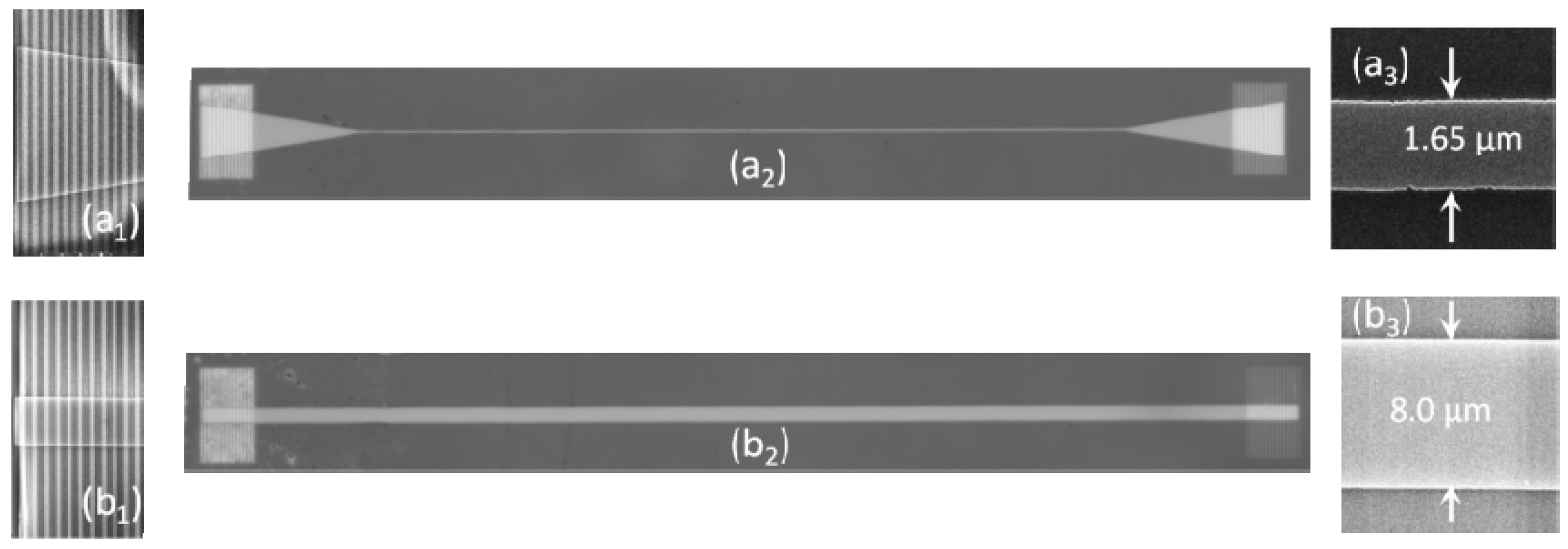
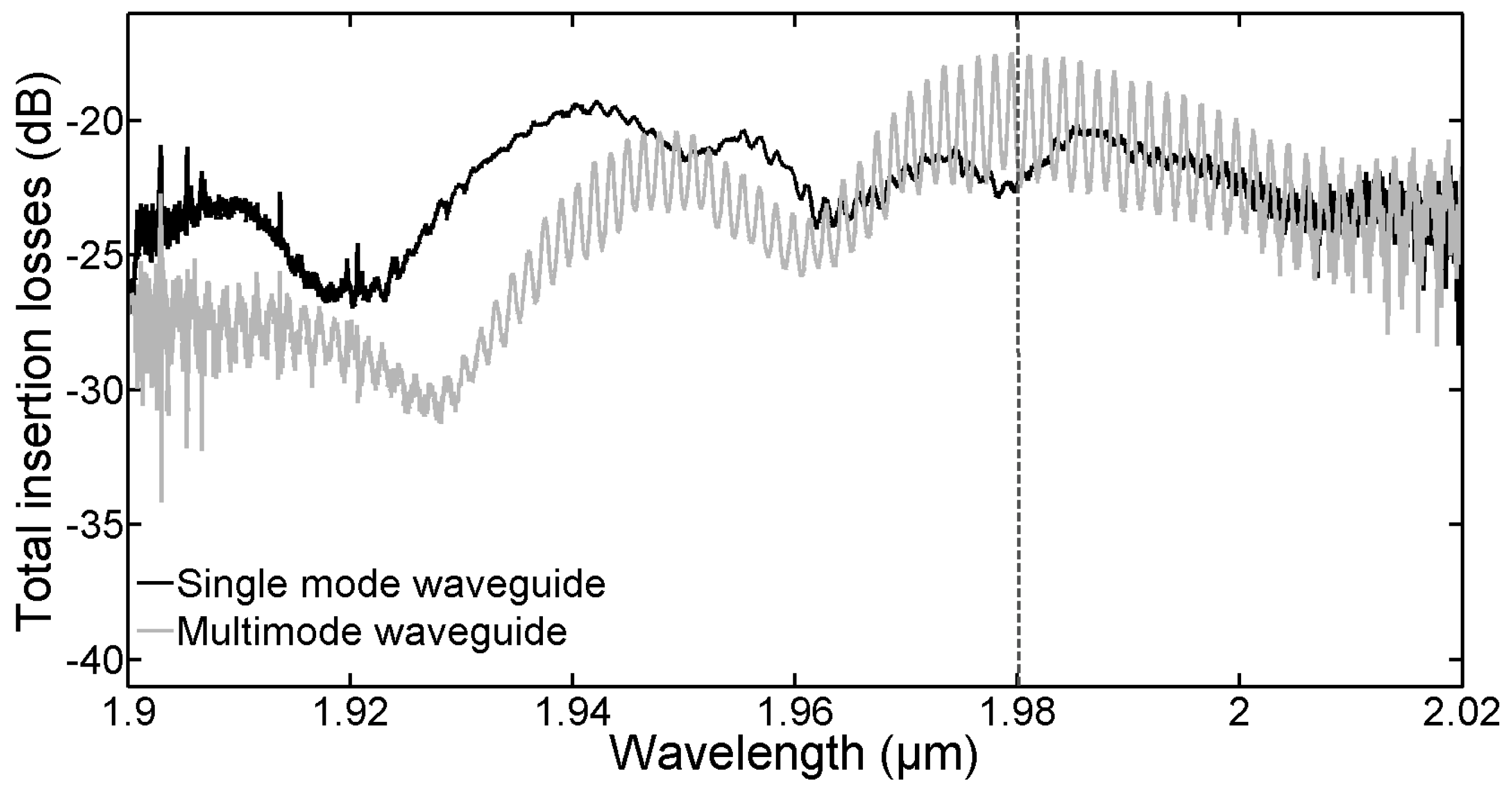
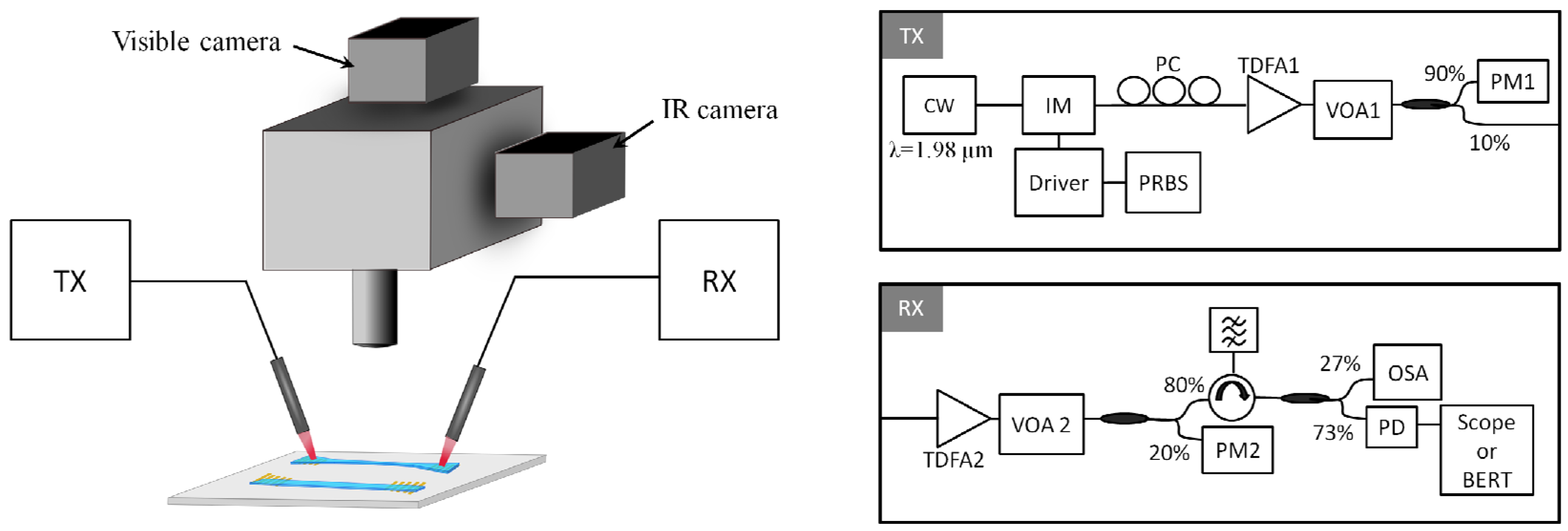
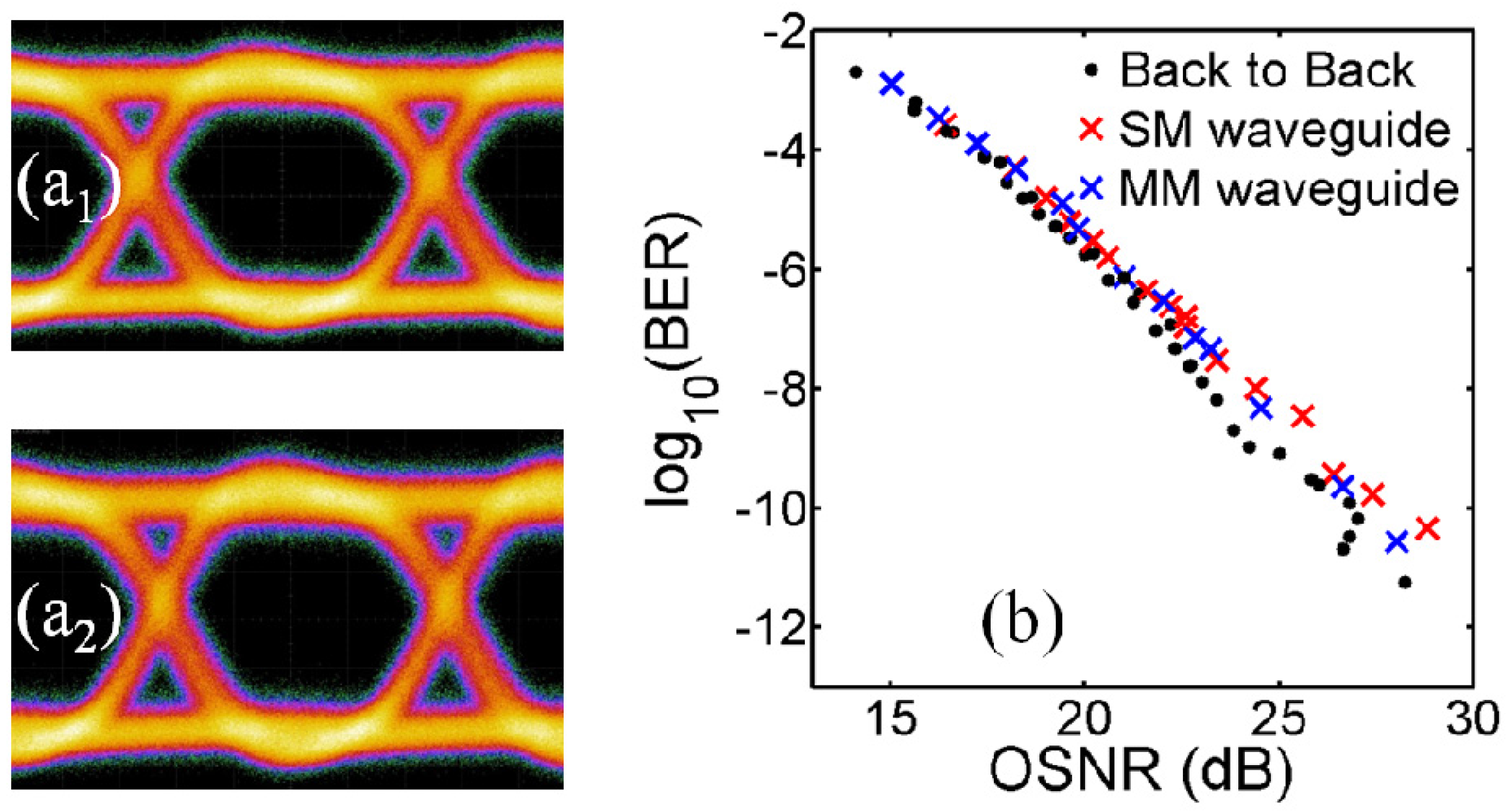
© 2017 by the authors. Licensee MDPI, Basel, Switzerland. This article is an open access article distributed under the terms and conditions of the Creative Commons Attribution (CC BY) license (http://creativecommons.org/licenses/by/4.0/).
Share and Cite
Lamy, M.; Finot, C.; Fatome, J.; Arocas, J.; Weeber, J.-C.; Hammani, K. Demonstration of High-Speed Optical Transmission at 2 µm in Titanium Dioxide Waveguides. Appl. Sci. 2017, 7, 631. https://doi.org/10.3390/app7060631
Lamy M, Finot C, Fatome J, Arocas J, Weeber J-C, Hammani K. Demonstration of High-Speed Optical Transmission at 2 µm in Titanium Dioxide Waveguides. Applied Sciences. 2017; 7(6):631. https://doi.org/10.3390/app7060631
Chicago/Turabian StyleLamy, Manon, Christophe Finot, Julien Fatome, Juan Arocas, Jean-Claude Weeber, and Kamal Hammani. 2017. "Demonstration of High-Speed Optical Transmission at 2 µm in Titanium Dioxide Waveguides" Applied Sciences 7, no. 6: 631. https://doi.org/10.3390/app7060631





